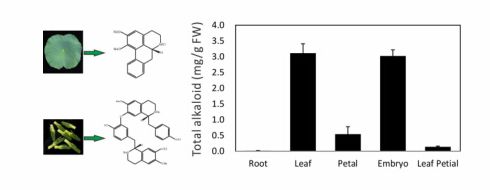
Lotus (Nemumbo species of the Nelumbonaceae family) has received considerable attention due to its high economic value as food, ornamental and medicinal uses. Alkaloids, the most important active components in lotus, distribute in many parts of lotus, however, little is known about their qualitative and quantitative distribution.
Dr. DENG Xianbao, supervised by Professor HAN Yuepeng of Wuhan Botanical Garden, conducted investigation of alkaloid composition and distribution in lotus. Using HPLC-MS/MS system, 10 alkaloids were identified from the extracts of different lotus organs. All the alkaloids belonged to benzylisoquinoline alkaloid (BIA) group. Spatially, lotus laminae and embryos concentrated the highest alkaloid content, followed by petalsand petioles. Lotus rhizome contained only trace amount alkaloids.
Lotus leaves and embryos contain totally different alkaloids. Leaves contain mainly aporphine-type alkaloids, whereas embryos contain dominantly bisbenzylisoquinoline-type alkaloids. In laminae, alkaloid accumulation increases during early developmental stages, reaches the highest level at full size stage, and then decreases slightly during senescence.
Alkaloid concentrations in leaves and embryos varied considerably among screened genotypes. Alkaloids, as important defense compounds, were significantly induced by mechanical wounding.
Results, entitled with “Analysis of isoquinoline alkaloid composition and wound-induced variation in Nelumbo using HPLC-MS/MS”, have been published online on Journal of Agricultural and Food Chemistry.
This research was supported by funds received from the National Natural Science Foundation of China and the Overseas Construction Plan for Science and Education Base, China-Africa Center for Research and Education, and the Chinese Academy of Sciences.

The spatial distribution of isoquinoline alkaloids in lotus (Image by DENG Xianbao)

86-10-68597521 (day)
86-10-68597289 (night)

86-10-68511095 (day)
86-10-68512458 (night)

cas_en@cas.cn

52 Sanlihe Rd., Xicheng District,
Beijing, China (100864)

